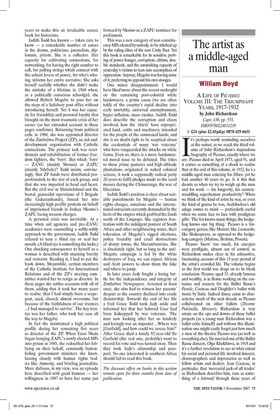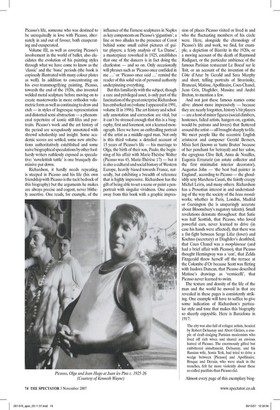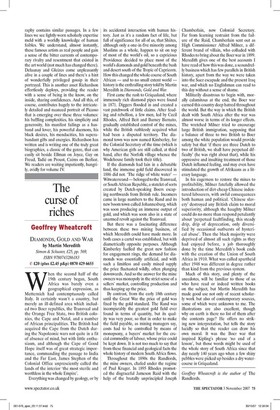The artist as a middle-aged man
William Boyd A LIFE OF PICASSO: VOLUME III: THE TRIUMPHANT YEARS, 1917-1932 by John Richardson Cape, £30, pp. 555, ISBN9780224031219 © £24 (plus £2.45p&p) 0870 429 6655 1 t's perhaps worth reminding ourselves at the outset, as we reach the third volume of John Richardson's stupendous biography of Picasso, exactly where we are. Picasso died in April 1973, aged 91, and it comes as something of a shock to realise that at the end of this volume, in 1932, he's a middle-aged man entering his fifties: yet he had another 40 years to go. Is it this that daunts us when we try to weigh up the man and his work — his longevity, his centurystraddling superhuman productivity? When we think of the kind of artist he was, or even the kind of genius he was, Archilochus's old adage comes to mind — particularly useful when we come face to face with prodigious gifts: 'The fox knows many things; the hedgehog knows one big thing.' Picasso is a foxcategory genius, like Mozart, like Leonardo, like Shakespeare, as opposed to the hedgehog-category (Matisse, Brahms, Proust).
Picasso 'knew' too much, his energies were profligate, almost out of control, as Richardson makes clear in his exhaustive, fascinating account of this 15-year period of the artist's crowded life. The volume begins as the first world war drags on to its bleak conclusion. Picasso, aged 35, already famous and wealthy, is in Rome working on the costumes and scenery for the Ballet Russe's Parade, Cocteau and Diaghilev's ballet with music by Satie. Indeed dance came to characterise much of the next decade as Picasso collaborated on other ballets (Tricome Pulcinella, Mercure). Richardson is very astute on the ups and downs of these ballet projects (as a young man Richardson was a ballet critic himself) and without this illumination one might easily forget just how much a man of the theatre Picasso was (as well as everything else). He married one of the Ballet Russe dancers, Olga Khokhlova, in 1918 and it's a further revelation to see to what extent his social and personal life involved dancers, choreographers and impresarios as well as fellow artists and dealers. Jean Cocteau, in particular, that 'mercurial jack-of-all trades' as Richardson describes him, runs as something of a leitmotif through these years of Picasso's life, someone who was destined to be unrequitedly in love with Picasso, alternately in and out of favour, both exasperating and exasperated.
Volume III, as well as covering Picasso's involvement in the world of ballet, also elucidates the evolution of his painting styles through what we have come to know as the 'classic' and the 'bone' periods (the book is copiously illustrated with many colour plates as well). In addition to concentrating on his ever-transmogrifying painting, Picasso, towards the end of the 1920s, also invented welded metal sculpture before moving on to create masterworks in more orthodox volumetric form as well as continuing to draw and etch — in styles of Ingresque representation and distorted semi-abstraction — a phenomenal repertoire of iconic still-lifes and portraits. Picasso's work and the art history of the period are scrupulously annotated with shrewd scholarship and insight. Some academic scores are settled, some new attributions authoritatively established and some naive biographical speculations by other foolhardy writers ruthlessly exposed as speculative: `novelettish tattle' is one brusquely dismissive put-down.
Richardson, it hardly needs repeating, is steeped in Picasso and his life (his own friendship with Picasso is the tacit bedrock of this biography) but the arguments he makes are always precise and cogent, never blithely assertive. One reads, for example, of the influence of the Farnese sculptures in Naples as key components on Picasso's `gigantism'; a line or two alludes to the presence of Corot behind some small cubist pictures of guitar players; a feisty analysis of 'La Danse', a masterpiece reworked in 1925, establishes that one of the dancers is in fact doing the charleston — and so on. Only occasionally will phrases such as 'Picasso once confided in me ...' or 'Picasso once said ...' remind the reader of this solid vein of personal authority underpinning everything.
But this familiarity with the subject, though a rare and privileged asset, is only part of the fascination of the great enterprise Richardson has embarked on (volume I appeared in 1991, volume II in 1996). The art history and scholarly annotation and correction are vital, but it can't be stressed enough that this is a biography, first and foremost, not a learned monograph. Here we have an enthralling portrait of the artist as a middle-aged man. Not only is this third volume a detailed account of 15 years of Picasso's life — his marriage to Olga, the birth of their son, Paulo, the beginning of his affair with Marie-Therese Walter (Picasso was 45, Marie-Therese 17) — but it is also a cultural and social history of Western Europe, heavily biased towards France, naturally, but exhibiting a breadth of reference that is highly impressive. Richardson has the gift of being able to set a scene or paint a penportrait with singular vividness. One comes away from this book with a graphic impression of places Picasso visited or lived in and who the fluctuating members of his circle were. Here, alongside the chronology of Picasso's life and work, we find, for example, a depiction of Biarritz in the 1920s, or a moving account of the death of Raymond Radiguet, or the particular ambience of the famous Parisian restaurant Le Boeuf sur le Toit, or an account of the invention of the Cote d'Azur by Gerald and Sara Murphy and short, telling portraits of Stravinsky, Brancusi, Matisse, Apollinaire, Coco Chanel, Juan Gris, Diaghilev, Massine and Andre Breton, to mention a few.
And not just these famous names come alive: almost more impressively — because they are nearly forgotten, history's bit players — are a host of minor figures (social climbers, hostesses, failed artists, hangers-on, egotists, would-be patrons and lovers) that fluttered around the artist — all brought sharply to life. We meet people like the eccentric English aristocrat and composer Gerald Berners, Misia Sert (known as 'tante Brutus' because of her penchant for betrayal) and her salon, the egregious Clive Bell, Anna de Noailles, Eugenia Errazuriz (an astute collector and the first minimalist interior decorator), Augustus John — `the best bad painter in England', according to Picasso — the ghoulishly sexy Marchesa Casati, the faintly creepy Michel Leiris, and many others. Richardson has a Proustian interest in and understanding of the way the society of the beau monde works, whether in Paris, London, Madrid or Garsington (he is unsparingly accurate about Bloomsbury's nugatory talents). Small revelations detonate throughout: that Satie was half Scottish, that Picasso, who loved powerful cars, never learned to drive (in case his hands were affected), that there was a fist-fight between Serge Lifar (lover) and Kochno (secretary) at Diaghilev's deathbed, that Coco Chanel was a morphineuse (and had a brief affair with Picasso), that Picasso thought Hemingway was a 'con', that Zelda Fitzgerald threw herself off the terrace at the Colombe d'Or because Scott was flirting with Isadora Duncan, that Picasso described Matisse's drawings as 'vermicelli', that Picasso never learned to swim.
The texture and density of the life of the man and the world he moved in that are revealed in these pages is consistently striking. One example will have to suffice to give some indication of Richardson's particular style and tone that makes this biography so sheerly enjoyable. Here is Barcelona in 1917: The city was also full of refugee artists, headed by Robert Delaunay and Abert Gleizes, a couple of draft-dodging Parisian modernists who lived off rich wives and shared an envious hatred of Picasso. The enormously gifted but embittered simultaneist, Delaunay, and his Russian wife, Sonia Terk, had tried to drive a wedge between [Picasso] and Apollinaire. Braque and Derain, who were stuck in the trenches, felt far more violently about these so-called pacifists than Picasso did.
Almost every page of this exemplary biography contains similar passages. In a few lines we see lightly-worn scholarly expertise meld with a worldly knowledge of human foibles. We understand, almost instantly, these famous artists as real people and gain a sense of the bitter currents of contemporary rivalry and resentment that existed in the art world (not much has changed there). Delaunay and Gleizes come unpleasantly alive in a couple of lines and there's a hint of wonderfully privileged gossip in their portrayal. This is another asset Richardson effortlessly deploys, providing the reader with a sense of being in the know, on the inside, sharing confidences. And all this, of course, contributes hugely to the intricately detailed and nuanced portrait of Picasso that is emerging over these three volumes: his baffling complexities, his simplicity and generosity, his manifest failings as a husband and lover, his powerful daemons, his black desires, his mendacities, his superabundant gifts and energies. Richardson has written and is writing one of the truly great biographies, a classic of the genre, that can easily sit beside Ellman on Joyce, Gay on Freud, Tadie on Proust, Cairns on Berlioz. We readers are waiting impatiently, hungrily, avidly for volume IV.














































































 Previous page
Previous page